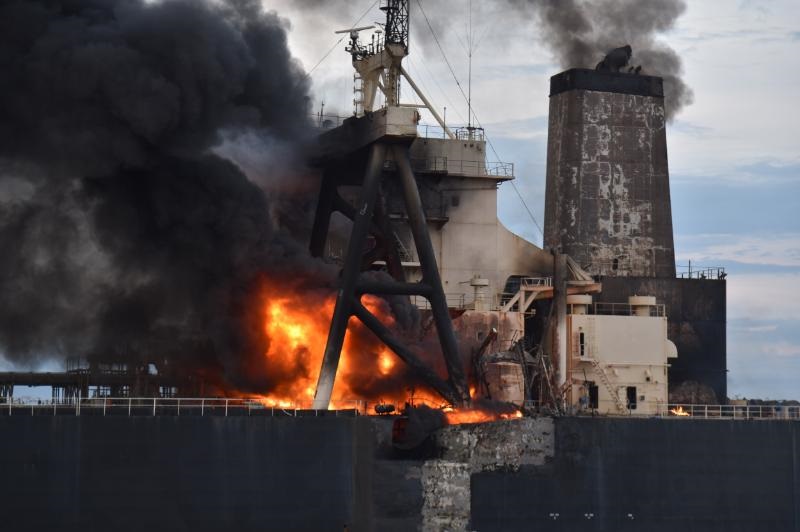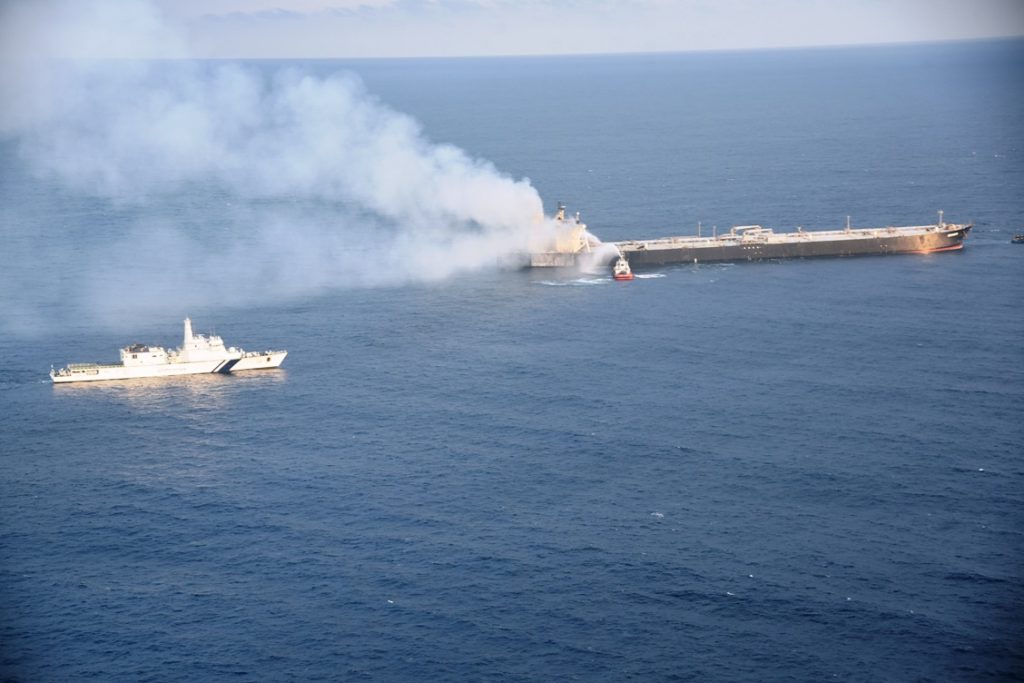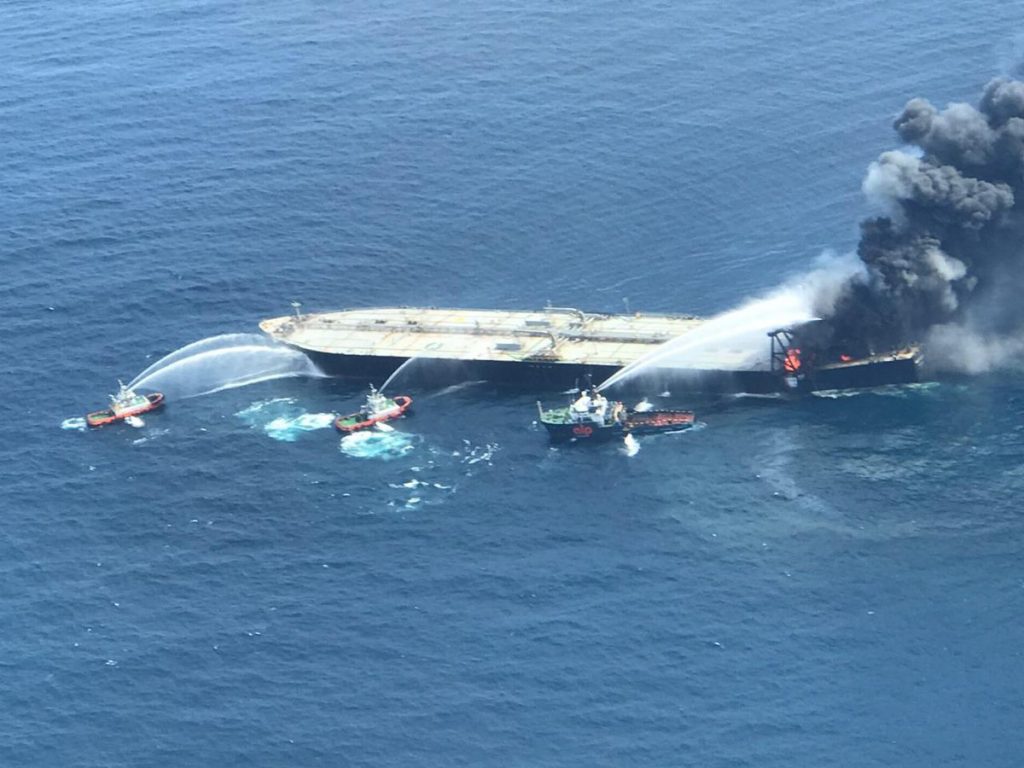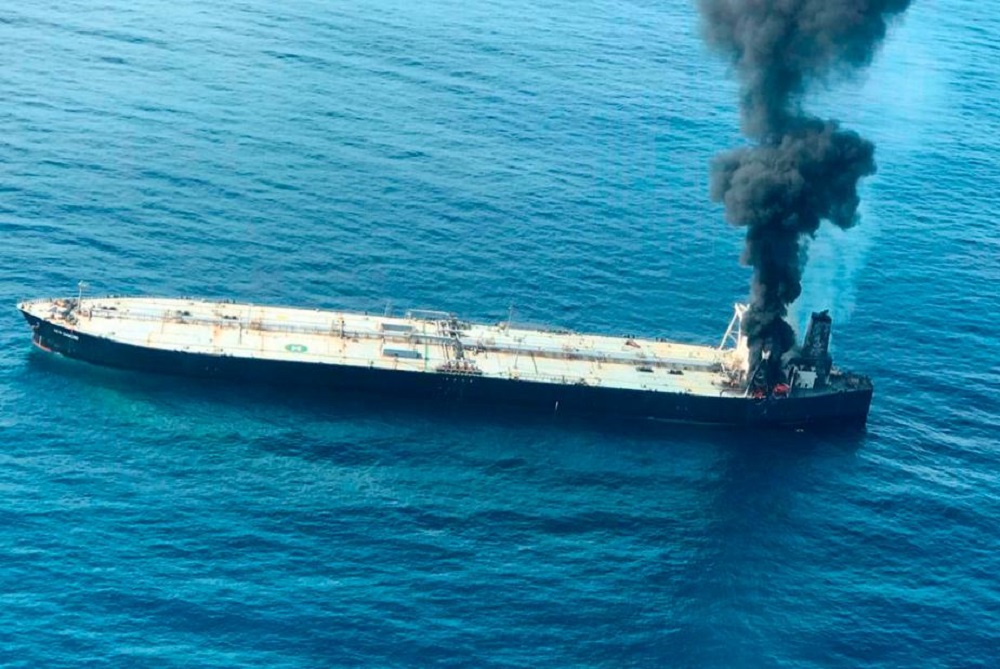Sri Lankan ships and Indian Coast Guard ships successfully towed the MT New Diamond more than 40 Nautical Miles away from Sri Lanka coast to safe waters, officials said.
The fire onboard oil tanker has been successfully contained into a greater extent. As a result of the combined operation the ill-fated oil tanker has been secured from all sides, Sri Lanka Navy said.
Although the ship had reached a distance of about 20 nautical miles by 6 pm yesterday (4), the ALP Winger, a tug, began taking the ship to the deep sea as fire was contained.
Further, the Sri Lanka Navy, Sri Lanka Air Force, Sri Lanka Ports Authority, Indian Navy and the Indian Coast Guard are working together in this coordinated disaster mitigation operation. The disaster relief operation was joined by Indian Coast Guard Ship (ICGS) Sarang, ICGS Sujay, TTT One – a tug equipped with firefighting equipment and professional firefighters, and 02 Dornier aircraft of Indian Coast Guard since previous night. The fire has been contained by now and the Dornier aircraft are currently at the Mattala Mahinda Rajapaksa International Airport.
Apart from that, SLNS Samudura, P4442 Fast Attack Craft and SLCG Samudraraksha and Samaraksha of Sri Lanka Coast Guard carrying the fire extinguishing chemicals provided by the government and private institutions in the event of this disaster, are also augmenting the disaster relief operation and providing necessary support.
As of now, 04 capital ships and 03 Fast Attack Craft of Sri Lanka Navy, 02 ships belonging to the Sri Lanka Coast Guard, 03 ships of Indian Coast Guard, 01 ship belonging to the Indian Navy, 02 tugs of Hambanthota International Port Group – Wasaba and Rawana, the ALP Winger tug, the TTT One tug with firefighting equipment and professionals have been engaged in the firefighting efforts. Meanwhile the MI 17 helicopter and the Beach Craft of the Sri Lanka Air Force will also resume their aerial operations to assist this combined effort.
The continuous cooling effect during the disaster relief operation has controlled the fire-spread and approaching of the flames to the crude oil store of MT New Diamond. As a result, there is no risk of an oil spill so far, it added.
Meanwhile, His Excellency Gotabaya Rajapaksa, President of Sri Lanka has expressed his gratitude to the Sri Lanka Navy, Air force, Sri Lanka Ports Authority and the Indian Defense Forces for their efforts in controlling the fires in MT New Diamond.
“I greatly appreciate your Contribution in conserving Marine biodiversity by preventing a disastrous situation out in the ocean,” the President tweeted.



FACTBOX: THE NEW DIAMOND
The 299,986 dead weight tonne (dwt) very large crude carrier (VLCC) tanker has a total capacity 340,104 cubic meters, or about 300,000 tonnes.
The fully-laden vessel was carrying about 2 million barrels (around 270,000 tonnes) of Kuwait oil valued at roughly $90 million to the Paradip refinery on India’s east coast when fire broke out in the engine on Thursday (September 3).
The 333-meter long double-hulled supertanker was built in 2000 by Mitsui Ichihara Engineering & Shipbuilding in Japan.
The 20-year-old New Diamond was previously sold at $26.5 million in January 2013, and the current market value is $21.28 million, according to VesselsValue, a company that tracks ships and vessel transactions.
The Panamanian-flagged tanker (IMO number 9191424) is owned by Liberia-based Porto Emporios Shipping Inc since 2013.
The vessel’s commercial and safety manager is Greece-based New Shipping Ltd, which has a fleet of 32 oil tankers and bulk carriers under its care, according to data from Equasis.org, a shipping transparency website.
In 1992, the United Nations shipping agency, the International Maritime Organization (IMO), mandated that all tankers of 5,000 dwt and more be fitted with double hulls to reduce the likelihood of leaks following the Exxon Valdez oil spill disaster in Alaska in 1989.
MAJOR OIL SPILLS WITH SHIPS
Following are some major oil spills involving ships and tankers.
1979 – The Atlantic Empress and the Aegean Captain, two fully loaded oil tankers, collided 10 miles (16.1 kms)off the coast of Tobago in a tropical rainstorm, spilling more than 2.1 million barrels of oil into the Caribbean.
1983 – The Castillo de Bellver exploded and sank off the coast of Cape Town carrying roughly 250,000 tonnes of crude oil.
1988 – The fully loaded tanker Odyssey operated by Polembros Shipping exploded and sank in the North Atlantic 700 miles off the coast of Nova Scotia, Canada, spilling 1 million barrels of oil.
1989 – The Exxon Valdez, an oil tanker bound for Long Beach, California, hit Prince William Sound in Alaska, dumping more than 250,000 barrels of crude oil into the sea killing animals and plants throughout Prince William Sound.
The accident, considered one of the worst human-caused environmental disasters, led to new rules requiring double-hulled ships in the region.
1991 – The oil tanker ABT Summer exploded about 900 miles off the coast of Angola, spilling its entire cargo of 1.9 million barrels at sea.
1996 – The Sea Empress went down on the rocks off Milford Haven on Britain’s west coast in 1996, in one of the country’s worst environmental disasters that saw over 70,000 tonnes of oil spilled.
1999 – The tanker Erika sank during a storm in December, leaking thousands of tonnes of oil into the Bay of Biscay off the coast of France and causing a major environmental disaster.
2011/2012 – In New Zealand’s worst environmental disaster in decades, hundreds of tonnes of oil leaked into the coastal waters and on to beaches off Tauranga on the east coast of New Zealand’s North Island from the stricken 47,230-tonne Liberian-flagged container ship Rena.
2018 – The suezmax Sanchi tanker carrying 136,000 tonnes of Iranian condensate collided with a cargo ship off Shanghai, caught fire and burned for a week. All 32 crew onboard were killed. Japan’s Coast Guard said at the time that oil which washed up on the shores of its southern islands was highly likely to have come from Sanchi.
2020 – The Wakashio, a Japanese bulk carrier, struck a coral reef off Mauritius’ coast in the Indian Ocean in July, spilling thousands of tonnes of crude oil into the sea and choking marine life in a pristine lagoon. 2020 – The New Diamond supertanker carrying about 2 million barrels of oil caught fire off the coast of Sri Lanka in September with one of the 23 crew members presumed dead.
Meanwhile, Sri Lanka Navy issued the following media statement on the situation;
Related to the press release under the title ‘Fire breaks out on Panama-flagged New Diamond oil tanker’ issued on 05th September 2020 at 1130 hrs
The distressed vessel is now about 40 nautical miles (about 74 km) away from the shore and Sri Lanka Navy and other stakeholders continue to engage in firefighting and inflict cooling effect on fire-stricken oil tanker using fire extinguishing chemicals and water, at peak of their efficiency. Meanwhile, two (02) more Indian Coast Guard Ships – Ameya and Abheek joined this consolidated operation this afternoon.
In the morning hours of today the sea area where the distressed vessel is remaining was rough and there was an increase in the speed of the sea breeze. However the disaster relief operation still continued in such circumstances the whole day to bring the blaze under control. Considering this calamity as an urgent matter of national importance the Sri Lanka Ports Authority (5000 L), Hambantota International Port Group (4600 L), Colombo Dockyard Limited (1000 L), Ceylon Petroleum Corporation (2100 L), Indian Oil Corporation (3000 L) and Ceylon Petroleum Storage Terminals Limited (2800 L) provided AFFF fire extinguishing chemicals to the Navy through the mediation of Marine Environment Protection Authority.
Meanwhile, at the intervention of the owner of the ship 10 British and Netherlands experts including rescue operation specialists, disaster evaluators and legal consultants will be arriving at the Mattala International Airport tomorrow morning. This team of experts is scheduled to be transferred by SLN Fast Attack Craft from Kalmunei to the sea area where the distressed vessel is currently at.
Apart from the missing seaman who is believed to be dead, the one undergoing treatment at hospital and distressed ship’s captain rest of crew (20) is currently safe onboard Sri Lanka Navy ships in isolation and arrangements will be made for them to be reunited with their families by telephone tomorrow.
In the meantime, 03 capital ships and 03 Fast Attack Craft of Sri Lanka Navy, 02 ships belonging to the Sri Lanka Coast Guard, 05 ships of Indian Coast Guard, 01 ship belonging to the Indian Navy, 02 tugs of Hambantota International Port Group – Wasaba and Rawana, the ALP Winger tug and the TTT One tug with firefighting equipment and professionals are being engaged in the firefighting efforts as of now. Apart from that, the MI 17 helicopter and the Beach Craft of the Sri Lanka Air Force also rendered assistance to this combined disaster relief efforts in the daytime.
As of this morning, two (02) Dornier aircraft belonging to the Indian Coast Guard had been stationed at the Mattala Mahinda Rajapaksa International Airport for emergency use. One of them left for India again after observing the current condition of the ship and disseminating information to the operation’s crew. Furthermore, the other Dornier is still engaged in surveillance in the area.
The Sri Lanka Navy and disaster mitigation operations teams have successfully controlled the spread of the fire on the ship and there is no danger of the ship leaking oil into the sea.























